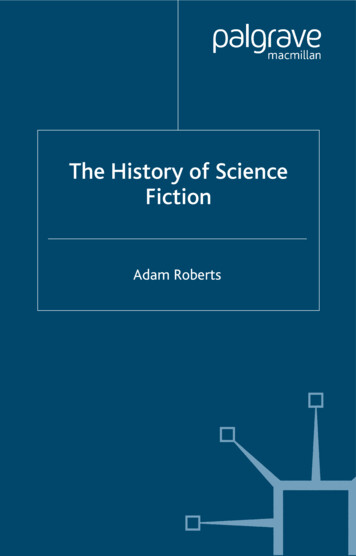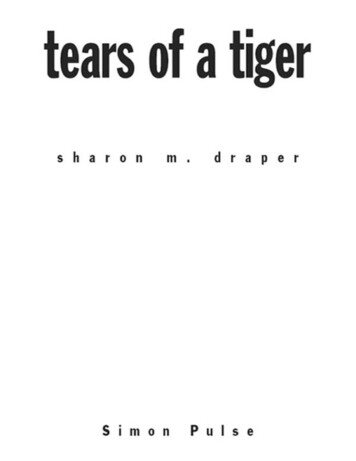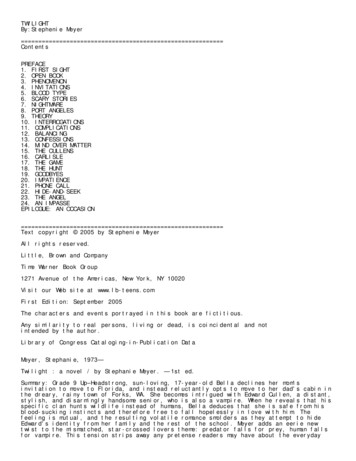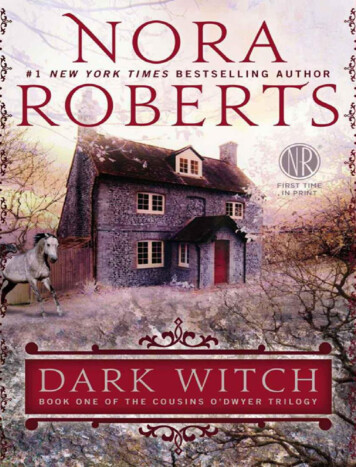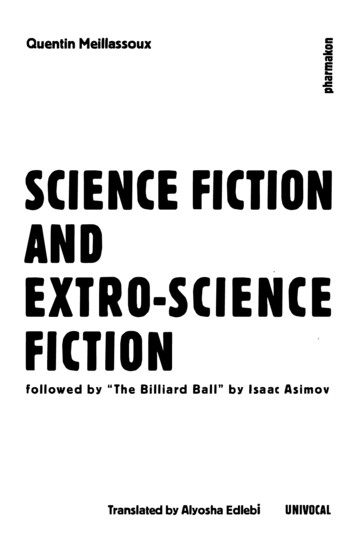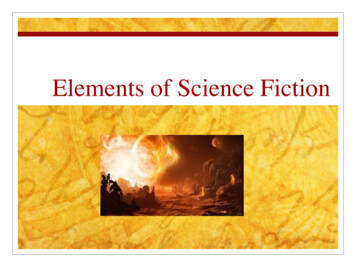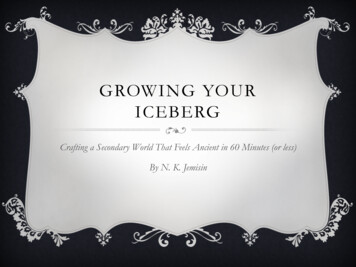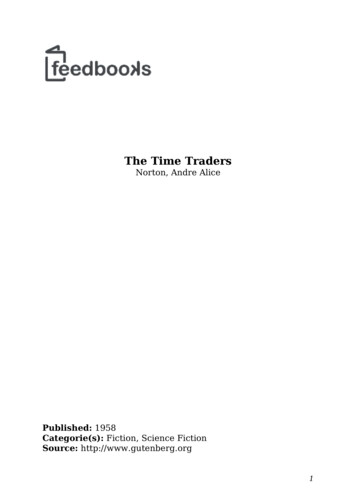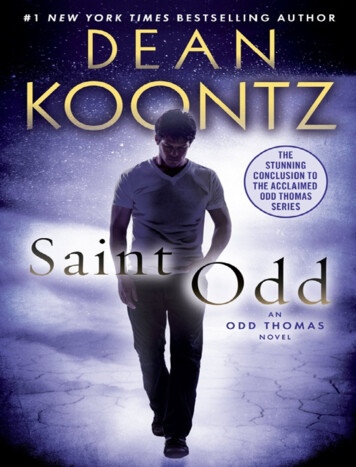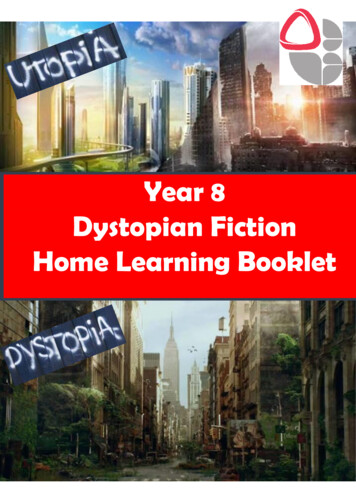
Transcription
Year 8Dystopian FictionHome Learning Booklet0
Week One:What is dystopian fiction?Utopia an imagined place or society in which everything is perfect.Dystopia an imagined place or society in which there is great suffering or injustice.Post-apocalyptic the time following a catastrophic event where they majority ofthe human race is wiped out and the world is changed dramatically, e.g. nuclearwar, zombie invasion, etc.Dystopian fiction made-up (not true) stories about societies where there areproblems with things like government rules, poverty, or oppression; sometimes setin a post-apocalyptic world.Dystopian Fiction / Films:Can you think of any books or films that are set in a dystopian society?Fiction (Books): The Hunger Games 1984Films: The Hunger Games I Am Legend1
TASK:Tick AGREE or DISAGREE next to each statement in the table below.Pick TWO of the statements and explain why you agree or disagree with them.STATEMENT 1:I AGREE / DISAGREE BECAUSE:STATEMENT 2:I AGREE / DISAGREE BECAUSE:2
Dystopian Elements and Characteristics:Basic Building Blocks of Dystopian Fiction Dystopia is subgenre of science fiction, because it depicts future fictional societies, andmany of them use other elements of science fiction like time travel, space flight, amazingand advanced technologies, etc. Dystopian stories are often about survival; their primary theme is oppression andrebellion. The environment plays an important role in dystopian fiction. Dystopian storiestake place in the future; usually in large cities devastated by pollution, war, revolutions,overpopulation and other disasters. Another characteristic of dystopian fiction is a strict division between the people orcharacters. This may be a separation by intellect, ability or class. In a typical dystopia, there is a strict government or leader who controls everything. Thereis also usually a protagonist (main character) who questions society, often feeling thatsomething is terribly wrong and tries to change it.Watch this short video called ‘How to recognise a dystopia’ and make notes.- look out for examples of dystopias- what influences writers to create dystopian fiction?TASKS:1. Read the information in the box above and watch the video clip (if you have internet access).What are the key features or characteristics of dystopian fiction?Create a bullet point list with as many details as possible:3
2. Think of a dystopian novel or film that you know of.Which key features / characteristics do they show?If you don’t know any dystopian novels or films, try researching them online or lookat the pictures below to give you inspiration.Novel or film name:Key features or characteristics of dystopian fiction:3. Create a dystopian fact-file outlining how and why it is a good exemplar of this genre.Include:- plot summary- main characters- key features and characteristics of dystopian fiction- reviews from readers and commentaries from experts- your personal opinion4
5
Reading an example of dystopian fictionExtract from Chapter One of 1984 by George OrwellOverview and extra reading available here.Summary of the entire novel is available here.6It was a bright cold day in April, and the clocks were striking thirteen.Winston Smith, his chin nuzzled into his chest in an effort to escape the vilewind, slipped quickly through the glass doors of Victory Mansions, though notquickly enough to prevent a swirl of gritty dust from entering along with him.The hallway smelt of boiled cabbage and old rag mats. At one end of it acoloured poster, too large for indoor display, had been tacked to the wall. Itdepicted simply an enormous face, more than a metre wide: the face of a manof about forty-five, with a heavy black moustache and ruggedly handsomefeatures. Winston made for the stairs. It was no use trying the lift. Even atthe best of times it was seldom working, and at present the electric currentwas cut off during daylight hours. This was part of the economy drive inpreparation for Hate Week. The flat was seven flights up and Winston, whowas thirty-nine and had a varicose ulcer above his right ankle, went slowly,resting several times on the way. On each landing, opposite the lift shaft, the poster with the enormousface gazed from the wall. It was one of those pictures which are so contrived that the eyes follow youabout when you move. BIG BROTHER IS WATCHING YOU, the caption beneath it ran.Inside the flat a fruity voice was reading out a list of figures which had something to do with the productionof pig-iron. The voice came from an oblong metal plaque like a dulled mirror which formed part of thesurface of the right-hand wall. Winston turned a switch and the voice sank somewhat, though the wordswere still distinguishable. The device (a telescreen, it was called) could be dimmed, but there was no wayof switching it off completely. He moved over to the window: a smallish, frail figure, the thinness of hisbody merely emphasised by the blue overalls which were the uniform of the Party. His hair was very fair,his face naturally ruddy, his skin roughened by coarse soap and blunt razor blades and the cold of thewinter that had just ended.Outside, even through the shut window-pane, the world looked cold. Down in the street little eddies ofwind were whirling dust and torn paper into spirals, and though the sun was shining and the sky a harshblue, there seemed to be no colour in anything, except the posters that were plastered everywhere. Theblack-moustachio’d face gazed down from every commanding corner. There was one on the house-frontimmediately opposite. BIG BROTHER IS WATCHING YOU, the caption said, while the dark eyes lookeddeep into Winston’s own. Down at street level another poster, torn at one corner, flapped fitfully in thewind, alternately covering and uncovering the single word INGSOC. In the far distance a helicopterskimmed down between the roofs, hovered for an instant like a bluebottle, and darted away with a curving6
flight. It was a police patrol, snooping into people’s windows. The patrols did not matter, however. Onlythe Thought Police mattered.Winston looked out of his window towards a huge building several kilometres away. The Ministry of Truthwas startlingly different from any other object in sight. It was an enormous pyramidal structure ofglittering white concrete, soaring up, terrace after terrace, three hundred metres into the air. From whereWinston stood it was just possible to read, picked out on its white face in elegant lettering, the threeslogans of the Party:WAR IS PEACE. FREEDOM IS SLAVERY. IGNORANCE IS STRENGTH.The Ministry of Truth contained, it was said, three thousand rooms above ground level and similarnumbers below. Scattered about London there were just three other buildings of similar appearance andsize. So completely did they dwarf the surrounding buildings that from the roof of Victory Mansions youcould see all four of them simultaneously. They were the homes of the four Ministries between which theentire government was divided. The Ministry of Truth which concerned itself with news, entertainment,education and the fine arts. The Ministry of Peace which concerned itself with war. The Ministry of Lovewhich maintained law and order. And the Ministry of Plenty which was responsible for economic affairs.Their names, in Newspeak: Minitrue, Minipax, Miniluv and Miniplenty.The Ministry of Love was the really frightening one. There were no windows in it at all. Winston had neverbeen inside the Ministry of Love, nor within half a kilometre of it. It was a place impossible to enter excepton official business, and then only by penetrating through a maze of barbed-wire entanglements, steeldoors and hidden machine-gun nests. Even the streets leading up to its outer barriers were roamed bygorilla-faced in black uniforms, armed with jointed truncheons.TASKS:1. Read the extract from 1984 (above).2. Highlight / underline any parts that show you this novel is set in a dystopian society.3. Write one of the quotes you have highlighted / underlined here and explain what is suggestsabout the type of society Winston is living in:QUOTE:This suggests that7
4. Identify five key features or conventions of dystopian fiction in this extract: CHALLENGE: Include a quote from the extract for each.5. A student read the extract from 1984 and said: ‘The society in which Winston lives soundspleasant and friendly.’ To what extent do you agree?In your answer, you should:- state whether you agree or disagree with the statement and explain why- include evidence (quotes) from the extract to support your opinion- explain what each quote tells the reader about the society Winston lives in- pick out some individual words or techniques used by the writer and explain their effect- include your personal opinion – would you like to live there? Why, or why not?AIM TO WRITE AT LEAST ONE PEE PARAGRAPH (you may need to use extra paper).8
Week Two:Setting in Dystopian Fiction The choice of setting is extremely important in a dystopian novel.Remember, a dystopia is a place where ‘normal life’ is different to how weknow it: post-apocalyptic, perhaps after a nuclear war or a world-widepandemic/disease; an extreme famine or starvation; an alien invasion; asociety where the government or single leader has total control; etc. A writer’s choice of setting can almost act as another character in adystopian novel; it helps create an expectation or impression for the readerof what might happen to the protagonist (main character), or helps them tosympathise with the characters’ suffering. This week, you are going to look at some examples of dystopian settings infiction. This will help you prepare for creating your own dystopian settingnext week. Look at the pictures below to give you an idea: 9
Setting: The Hunger Games – Suzanne CollinsOur house is almost at the edge of the seam. I only have to pass a few gatesto reach the scruffy field called the Meadow. Separating the meadow fromthe woods, in fact enclosing all of District 12, is a high chain-link fence toppedwith barbed wire loops. In theory, it’s supposed to be electrified twenty-fourhours a day as a deterrent to the predators that live in the woods – packs ofwild dogs, lone cougars, bears – that used to threaten our streets. But sincewe’re lucky to get two or three hours of electricity in the evenings, it’s usuallysafe to touch. Even so, I always take a moment to listen carefully for the humthat means the fence is live. Right now, it’s silent as a stone. Concealed by aclump of bushes, I flatten out on my belly and slide under a meter-longstretch that’s been loose for years. There are several other weak spots in thefence, but this one is so close to home I almost always enter the woods here.As soon as I’m in the trees, I retrieve a bow and sheath of arrows from a hollow log. Electrified or not, thefence has been successful at keeping the flesh-eaters out of District 12. Inside the woods they roam freely,and there are added concerns like venomous snakes, rabid animals, and no real paths to follow. But there’salso food if you know how to find it. My father knew and he taught me some ways before he was blown tobits in a mine explosion. There was nothing left of him to bury. I was eleven then. Five years later, I stillwake up screaming for him to run.In the woods waits the only person with whom I can be myself. Gale. I can feel the muscles in my facerelaxing, my pace quickening as I climb the hills to our place, a rock ledge overlooking a valley. A thicket ofberry bushes protect it from unwanted eyes. The sight of him waiting there brings on a smile. Gale says Inever smile except in the woods.TASKS: Read The Hunger Games extract (above). Look for and highlight these language features used by the author to describe the setting:o Simileo 3-part lists (there are two to find!)o Alliterationo Onomatopoeia (a word that sounds like the noise it makes, e.g. Bang!)o Imageryo Personification (giving human characteristics to something non-human) CHALLENGE: How does the narrator (Katniss Everdeen) feel about the setting?Explain your answer and include quotes in your response.10
Setting: Ready Player One – Ernest ClineOur trailer was near the northern edge of the stacks, whichran up to a crumbling highway overpass. From my vantagepoint at the laundry room window, I could see a thin stream ofelectric vehicles crawling along the cracked asphalt, carryinggoods and workers into the city. As I stared out at the grimskyline, a bright sliver of the sun peeked over the horizon.Watching it rise, I performed a mental ritual: Whenever I sawthe sun, I reminded myself that I was looking at a star. One ofover a hundred billion stars in our galaxy. A galaxy that wasjust one of billions of other galaxies in the observableuniverse. This helped me keep things in perspective. I’dstarted doing it after watching a science program from the early ‘80s called Cosmos.I slipped out the window as quietly as possible and, clutching the bottom of the window frame, slid downthe cold surface of the trailer’s metal siding. The steel platform on which the trailer rested was only slightlywider and longer than the trailer itself, leaving a ledge about a foot and a half wide all the way around. Icarefully lowered myself until my feet rested on this ledge, then reached up to close the window behindme. I grabbed hold of a rope I’d strung there at waist level to serve as a hand hold and began to sidestepalong the ledge to the corner of the platform. From there I was able to descend the ladder-like frame ofthe scaffolding. I almost always took this route when leaving or returning to my aunt’s trailer. A ricketymetal staircase was bolted to the side of the stack, but it shook and knocked against the scaffolding, so Icouldn’t use it without announcing my presence. Bad news. In the stacks, it was best to avoid being heardor seen, whenever possible. There were often dangerous and desperate people about when I reached the bottom level, I jumped off the scaffold and dropped the few remaining feet to theground. My rubber boots crunched into the slush and frozen mud. It was still pretty dark down here, so Itook out my flashlight and headed east, weaving my way through the dark maze, doing my best to remainunseen while being careful to avoid tripping over a shopping cart, engine block, or one of the other piecesof junk littering the narrow alleys between the stacks. I rarely saw anyone out at this time of the morning.The commuter shuttles ran only a few times a day, so the residents lucky enough to have a job wouldalready be waiting at the bus stop by the highway. Most of them worked as day labourers in the giantfactory farms that surrounded the city.After walking about half a mile, I reached a giant mound of old cars and trucks piled haphazardly along thestacks’ eastern perimeter. Decades ago, the cranes had cleared the park of as many abandoned vehicles aspossible, to make room for even more stacks, and they’d dumped them in huge piles like this one allaround the settlement’s perimeter. Many of them were nearly as tall as the stacks themselves.I walked to the edge of the pile, and after a quick glance around to make sure I wasn’t being watched orfollowed, I turned sideways to squeeze through a gap between two crushed cars. From there, I ducked,clambered, and sidestepped my way farther and farther into the ramshackle mountain of twisted metal,11
until I reached a small open space at the rear of a buried cargo van. Only the rear third of the van wasvisible. The rest was concealed by the other vehicles stacked on and around it. Two overturned pickuptrucks lay across the van’s roof at different angles, but most of their weight was supported by the carsstacked on either side, creating a kind of protective arch that prevented the van from being crushed by themountain of vehicles piled above it.I pulled out a chain I kept around my neck, on which there hung a single key. In a stroke of luck, this keyhad still been hanging from the van’s ignition when I’d first discovered it. Many of these vehicles had beenin working condition when they were abandoned. Their owners had simply no longer been able to affordfuel for them, so they’d just parked them and walked away.I pocketed my flashlight and unlocked the van’s rear right door. It opened about a foot and a half, givingme just enough room to squeeze inside. I pulled the door closed behind me and locked it again. The van’srear doors had no windows, so I was hunched over in total darkness for a second, until my fingers foundthe old power strip I’d duct-taped to the ceiling. I flipped it on, and an old desk lamp flooded the tiny spacewith light.The crumpled green roof of a compact car covered the crushed opening where the windshield had been,but the damage to the van’s front end didn’t extend beyond the cab. The rest of the interior remainedintact. Someone had removed all of the van’s seats (probably to use as furniture), leaving a small “room”about four feet wide, four feet high, and nine feet long.This was my hideout. This van was my refuge. My Batcave. My Fortress of Solitude. It was where I attended school, did myhomework, read books, watched movies, and played videogames. It was also where I conducted my ongoing quest to find Halliday’s Easter egg.TASKS: Read the Ready Player One extract (above). Look for and highlight these language features used by the author to describe the setting:o Metaphoro 3-part listso Alliterationo Onomatopoeia (a word that sounds like the noise it makes, e.g. Bang!)o Imageryo Personification (giving human characteristics to something non-human) CHALLENGE: How does the narrator (Wade Watts) feel about the setting?Explain your answer and include quotes in your response.12
Compare the two settings:Ready Player OneHow do the authors present the setting in these extracts?BothThe Hunger GamesIdea 1:Idea 1: Both present the settingas dangerous.Idea 1:Quote 1:Quote 1 (Hunger Games):‘packs of wild dogs, lonecougars, bears’Quote 1:Quote 1 (Ready Player One):‘mound of old cars and truckspiled haphazardly‘Idea 2:Idea 2:Quote 2:Quote 2:Idea 3:Idea 3:Quote 3:Quote 3:EXTENSION HINT: Try to think of examples that support big ideas. i.e. the setting is dangerous, the setting is special tothe speaker, the setting is isolated from the rest of the population Plan for at least 3 areas of comparison.e.g.P 1: Both present the setting as dangerous– Ready Player One: 3 part list (‘avoid tripping over a shopping cart, engine block, or one of the other pieces ofjunk’) Imagery (‘mound of old cars and trucks piled haphazardly‘) Metaphor (‘the ramshackle mountain of twisted metal’)– The Hunger Games: 3 part list (x2!): (‘packs of wild dogs, lone cougars, bears’; ‘venomous snakes, rabid animals,and no real paths to follow’) Onomatopoeia, Personification: (‘I always take a moment to listen carefully for the hum thatmeans the fence is live’)13
Compare the two settings:How do the authors present the setting in these extracts?Use your ideas from the table on the previous page to compare the settings used in The Hunger Gamesand Ready Player One. Aim to write three paragraphs – you may need extra paper.Sentence starters (if you need them!):Key wordsThe writer presents the setting in as This is seen in the quote This quote suggests that The use of the [language feature] creates the impression that The word ‘ ’ implies This is similar / different to the setting in the other extract because loussimilemetaphorpersonificationthree-part listimageryonomatopoeia14
Creating Your Own Dystopian Setting By now, you should have an idea of what a dystopia is, some key characteristics ofdystopian fiction, and what a dystopian setting could look like. This week, you are going to create your own dystopian setting.Look back at Week Three if you need reminding. You will eventually write your own piece of dystopian fiction, so this setting could bethe basis for your story when we come to plan it next week! Use the space below to plan some ideas before drawing your setting on the next page.Where is it set?(a town, city, differentcountry or planet?)What makes it dystopian?(post-apocalyptic, alieninvasion, deadly pandemic,controlling leader orgovernment, or other?)DystopianSettingWhen is it set?(the present day or inthe future?)Any other details orideas?15
Begin by drawing your dystopian setting below:16
TASK:Using your drawing to guide you (or the image above if you are still unsure), write a description of yourdystopian setting. Remember to use punctuation and descriptive language techniques.*NOTE – This is not your dystopian story (yet!). The purpose of the description is to create a clear imageof your setting in your head before we start planning your story. You may need extra paper.17
Week Three:CharacterIf you read dystopian fiction, or you have watched some dystopian films, you may already know whattype of characters to expect.Below is a list of ‘typical’ characters you might find in a dystopian novel: a protagonist who feels something is wrong with society, or feels trapped and wants to escape;they question the existing society and may aim to change something – usually brave and thesecharacters allow the reader to experience the dystopian society through their eyes an oppressive leader or group - perhaps the government you may find a character based on technological / scientific advances – e.g. aliens, robots,monsters, etc.Extract from Frankenstein by Mary ShelleyIt was on a dreary night of November that I beheld the accomplishment of my toils.With an anxiety that almost amounted to agony, I collected the instruments of lifearound me, that I might infuse a spark of being into the lifeless thing that lay at myfeet. It was already one in the morning; the rain pattered dismally against thepanes, and my candle was nearly burnt out, when, by the glimmer of the halfextinguished light, I saw the dull yellow eye of the creature open; it breathed hard,and a convulsive motion agitated its limbs.How can I describe my emotions at this catastrophe, or how delineate the wretch whom with such infinitepains and care I had endeavoured to form? His limbs were in proportion, and I had selected his features asbeautiful. Beautiful! Great God! His yellow skin scarcely covered the work of muscles and arteries beneath;his hair was of a lustrous black, and flowing; his teeth of a pearly whiteness; but these luxuriances onlyformed a more horrid contrast with his watery eyes, that seemed almost of the same colour as the dunwhite sockets in which they were set, his shrivelled complexion and straight black lips.Glossarytoils work, effortconvulsive sudden, jerkyagitated disturbeddelineate definewretch unfortunate creatureendeavoured triedlustrous shiny, glossydun off-white / greycomplexion skin18
TASKS:1. Read the extract from Frankenstein (previous page).This extract from chapter five of Frankenstein depicts the creature being brought to life.This novel introduced the idea of a ‘mad-scientist’ to popular culture.2. Highlight / underline any quotes that describe:a. The settingb. The monsterc. Frankenstein (he is the scientist, NOT the monster!):3. Write one of the quotes you have highlighted / underlined here and explain what is suggestsabout the thing it is describing.QUOTE:This suggests that4. CHALLENGE: Write a minimum of two PEE paragraphs in response to this question:How does Shelley create and convey setting and character in the extract?19
Your own dystopian character By now, you should have an idea of what a dystopia is, some typical characters oftenfound in dystopian fiction, and what a dystopian character could look like. Today, you are going to create your own dystopian character. You will be writing your own piece of dystopian fiction in the next couple of weeks, sothis character could be the protagonist (main character; hero) or antagonist (rival /enemy of the protagonist) of your story. Use the space below to plan some ideas before drawing your character on the nextpage. You can plan / draw more than one character if you like, but no more than two.Appearance PersonalityWhat is theirpurpose in thestory?Who is your main character?(Think about your choice ofsetting – make sure they makesense together!)What makes themdystopian?(How have they beenaffected by your choice ofdystopia: post-apocalyptic,alien invasion, deadlypandemic, controllingleader or government, orother?)DystopianCharacterWho is their main rival?(Who or what is yourprotagonist fightingagainst? i.e.an evil leader, an alieninvasion, a zombieapocalypse, etc.)Any other details orideas?If you are unsure, watch this video for a visual guide to dystopian examples in modern culture.20
Begin by drawing your dystopian character/s below.If you have planned more than one character, you may want to split this page up.Label the key features / characteristics of each of your dystopian characters.E.g.Explain why you have designed them to look or act a certain way.Do they have any weapons or special capabilities?Does anything make them dystopian, or are they living in a dystopian society and fighting against it?21
PlotOver the last few weeks we have worked on the following: Understanding what dystopian fiction is Recognising and creating a dystopian setting Creating a dystopian character (protagonist and / or antagonist)Next step plot!To write a successful narrative, or story, you need to have a plan of the plot, or storyline:- What is your story about? What is the purpose?- What happens to the main character?- Does something dramatic happen (the climax) – e.g. a major discovery, a fight, a death?- How does it end?THE PLANOver the next few weeks, your task is to create a piece of dystopian fiction.You can choose either:a) An opening to a dystopian storyb) A dystopian short story.TODAY’S TASK:Decide what your dystopian short-story is going to be about and create a detailed plan.Some dystopian fiction writing prompts can be found here or on the next page.A dystopian plot generator is available here if you need further support.Your plan should include IDEAS for the following (we don’t want the full story yet): Beginning: Outline the setting and your main character/s. Include thorough and detaileddescription. What kind of world are they living in? Reveal how or why this could be considereda dystopian society – think about how you will reveal this slowly and subtly. Rising Action: Introduce a problem – what is your protagonist unhappy with, or trying toachieve? How will they get there? What could stand in their way? Climax: The highest point of action or suspense – does your protagonist meet the antagonist?Do they discover something shocking? Is there a struggle, a fight, or a death? Falling Action / Resolution: Is there a resolution? Remember – there does not need to be a‘happily ever after’. What happens to your characters? Has anything changed?22
Dystopian Writing Prompts; choose one to help inspire your story!23
Plan your short story using the prompts below:First Sentence: direct speech,exclamation, question? Engageyour reader from the beginning.Beginning: Outline the settingand your main character/s.Include thorough and detaileddescription. What kind of worldare they living in? Reveal how orwhy this could be considered adystopian society – think abouthow you will reveal this slowlyand subtly.Rising Action: Introduce aproblem – what is yourprotagonist unhappy with, ortrying to achieve? How will theyget there? What could stand intheir way?Climax: The highest point ofaction or suspense – does yourprotagonist meet the antagonist?Do they discover somethingshocking? Is there a struggle, afight, or a death?Falling Action / Resolution: Isthere a resolution? Remember –there does not need to be a‘happily ever after’. Whathappens to your characters? Hasanything changed?ClimaxRisingActionResolutionBeginning24
Week Four:Writing your dystopian storyREMINDERYour task is to create a piece of dystopian fiction.You can choose either:a) An opening to a dystopian storyb) A dystopian short story.Use the knowledge, notes and plan you have developed over the last few weeks to write yourdystopian story here. Aim to write, or type, a maximum of 2.5 sides of A4.25
26
27
Self-Assessment and EditingFirstly, a HUGE well done to you all for completing this unit of home-learning. Hopefully you are proud of the work you have created.This week, I want you to focus on self-assessing and improving your writing.TASK 1:1. Identify any dystopian features you have included in your story – highlight, underline or draw a boxaround them. These could be anything from the list below:- the setting could be post-apocalyptic, war-torn, ruled by a strict leader or government, etc.- a protagonist – a hero trying to save or change something- an antagonist – the enemy or rival; the person preventing the protagonist’s success- technological advances – e.g. robots, weapons, new inventions, etc.- any other dystopian features you have studied and included.2. Highlight or underline all language devices (e.g. simile, metaphor, personification) you have used andlabel which device it is next to it.3. Highlight or circle any ambitious word choices you think you have made.TASK 2:Read each statement and put a tick in the correct box.YESNOI have included some dystopian features in my writing.I spent time planning before writing.There is a clear structure to my writing – e.g. a definite beginning, middle and end.My paragraphs link together in a logical sequence to create cohesion.I have included some detailed description of the setting and each character.I have tried to use a range of language devices to make my ideas interesting.I have tried to use a range of structural devices to make my ideas int
science fiction, because it depicts future fictional societies, and many of them use other elements of science fiction like time travel, space flight, amazing and advanced technologies, etc. Dystopian stories are often about . survival; their primary theme is oppression and rebellion.
